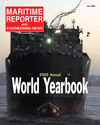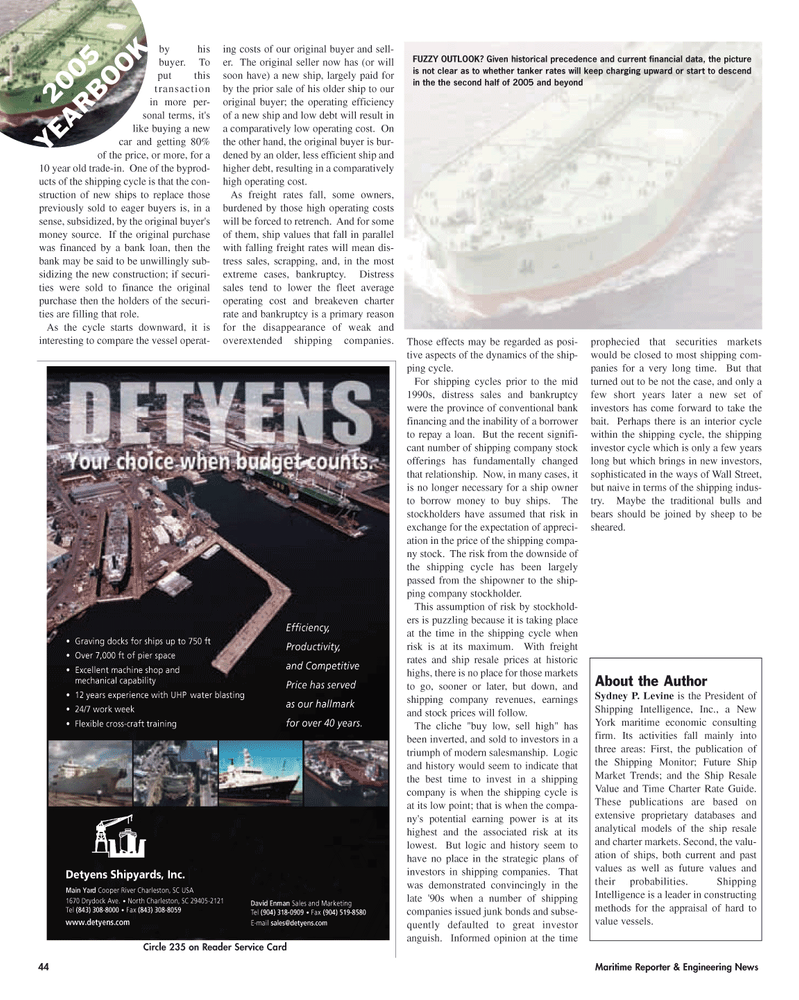
Page 4: of Maritime Reporter Magazine (June 2005)
Annual World Yearbook
Read this page in Pdf, Flash or Html5 edition of June 2005 Maritime Reporter Magazine
by his buyer. To put this transaction in more per- sonal terms, it's like buying a new car and getting 80% of the price, or more, for a 10 year old trade-in. One of the byprod- ucts of the shipping cycle is that the con- struction of new ships to replace those previously sold to eager buyers is, in a sense, subsidized, by the original buyer's money source. If the original purchase was financed by a bank loan, then the bank may be said to be unwillingly sub- sidizing the new construction; if securi- ties were sold to finance the original purchase then the holders of the securi- ties are filling that role.
As the cycle starts downward, it is interesting to compare the vessel operat- ing costs of our original buyer and sell- er. The original seller now has (or will soon have) a new ship, largely paid for by the prior sale of his older ship to our original buyer; the operating efficiency of a new ship and low debt will result in a comparatively low operating cost. On the other hand, the original buyer is bur- dened by an older, less efficient ship and higher debt, resulting in a comparatively high operating cost.
As freight rates fall, some owners, burdened by those high operating costs will be forced to retrench. And for some of them, ship values that fall in parallel with falling freight rates will mean dis- tress sales, scrapping, and, in the most extreme cases, bankruptcy. Distress sales tend to lower the fleet average operating cost and breakeven charter rate and bankruptcy is a primary reason for the disappearance of weak and overextended shipping companies.
Those effects may be regarded as posi- tive aspects of the dynamics of the ship- ping cycle.
For shipping cycles prior to the mid 1990s, distress sales and bankruptcy were the province of conventional bank financing and the inability of a borrower to repay a loan. But the recent signifi- cant number of shipping company stock offerings has fundamentally changed that relationship. Now, in many cases, it is no longer necessary for a ship owner to borrow money to buy ships. The stockholders have assumed that risk in exchange for the expectation of appreci- ation in the price of the shipping compa- ny stock. The risk from the downside of the shipping cycle has been largely passed from the shipowner to the ship- ping company stockholder.
This assumption of risk by stockhold- ers is puzzling because it is taking place at the time in the shipping cycle when risk is at its maximum. With freight rates and ship resale prices at historic highs, there is no place for those markets to go, sooner or later, but down, and shipping company revenues, earnings and stock prices will follow.
The cliche "buy low, sell high" has been inverted, and sold to investors in a triumph of modern salesmanship. Logic and history would seem to indicate that the best time to invest in a shipping company is when the shipping cycle is at its low point; that is when the compa- ny's potential earning power is at its highest and the associated risk at its lowest. But logic and history seem to have no place in the strategic plans of investors in shipping companies. That was demonstrated convincingly in the late '90s when a number of shipping companies issued junk bonds and subse- quently defaulted to great investor anguish. Informed opinion at the time prophecied that securities markets would be closed to most shipping com- panies for a very long time. But that turned out to be not the case, and only a few short years later a new set of investors has come forward to take the bait. Perhaps there is an interior cycle within the shipping cycle, the shipping investor cycle which is only a few years long but which brings in new investors, sophisticated in the ways of Wall Street, but naive in terms of the shipping indus- try. Maybe the traditional bulls and bears should be joined by sheep to be sheared.
FUZZY OUTLOOK? Given historical precedence and current financial data, the picture is not clear as to whether tanker rates will keep charging upward or start to descend in the the second half of 2005 and beyond 2005
YEARBOOK
Efficiency,
Productivity, and Competitive
Price has served as our hallmark for over 40 years. • Graving docks for ships up to 750 ft • Over 7,000 ft of pier space • Excellent machine shop and mechanical capability • 12 years experience with UHP water blasting • 24/7 work week • Flexible cross-craft training
Detyens Shipyards, Inc.
Main Yard Cooper River Charleston, SC USA 1670 Drydock Ave. • North Charleston, SC 29405-2121
Tel (843) 308-8000 • Fax (843) 308-8059 www.detyens.com
David Enman Sales and Marketing
Tel (904) 318-0909 • Fax (904) 519-8580
E-mail [email protected]
About the Author
Sydney P. Levine is the President of
Shipping Intelligence, Inc., a New
York maritime economic consulting firm. Its activities fall mainly into three areas: First, the publication of the Shipping Monitor; Future Ship
Market Trends; and the Ship Resale
Value and Time Charter Rate Guide.
These publications are based on extensive proprietary databases and analytical models of the ship resale and charter markets. Second, the valu- ation of ships, both current and past values as well as future values and their probabilities. Shipping
Intelligence is a leader in constructing methods for the appraisal of hard to value vessels.
Circle 235 on Reader Service Card 44 Maritime Reporter & Engineering News
MR JUNE 2005 #6 (41-48).qxd 6/6/2005 11:01 AM Page 4

 3
3

 5
5
